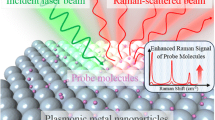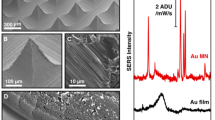Abstract
In this contribution, we quantify the fine-tuning of surface plasmon resonance via nanoparticle coating of gold SPR chips. We target preparation of atomically flat surface with defined charge, needed for scanning probe characterization of biomolecules, with simultaneous optimization of in situ SPR sensitivity during immobilization of these molecules. Using total internal reflection ellipsometry, we show that the goal can be achieved by combination of charge-stabilized silver nanoparticles over underlying gold chip of reduced thickness. The provided formulas for optimal silver to gold thickness relation are valid for arbitrary analyte and the method was experimentally verified on binding of Rtt103 protein.







Similar content being viewed by others
Availability of Data and Materials
The datasets generated and/or analyzed during the current study are available from the corresponding author on reasonable request.
Notes
Since we are to work with p-polarized light exclusively, we will mostly omit the polarization distinguishing indexes for brevity.
References
Maver U, Planišek O, Jamnik J, Hassanien AI, Gaberšček M (2012) Prepearation of Atomically Flat Gold Substrates for AFM Measurements. Acta Chim Slov 59(1):212–219
Prochazka P, Mach J, Bischoff D et al (2014) Ultrasmooth metallic foils for growth of high quality graphene by chemical vapor deposition. Nanotechnology 25:185601
Homola J (2003) Present and future of surface plasmon resonance. Anal Bioanal Chem 377(3):528–539
Wang Z, Cheng Z, Singh V, Zheng Z, Wang Y, Li S, Song L, Zhu J (2013) Stable and Sensitive Silver Surface Plasmon Resonance Imaging Sensor Using Trilayered Metallic Structures. Anal Chem 86:1430–1436
Chu H-Ch, Kuo Ch-H, Huang MH (2006) Thermal Aqueous Solution Approach for the Synthesis of Triangular and Hexagonal Gold Nanoplates with Three Different Size Ranges. Inorg Chem 45(2):808–813
Deckert-Gaudig T, Deckert V (2009) Ultraflat Transparent Gold Nanoplates - Ideal Substrates for Tip-Enhnanced Raman Scattering Experiments. Small 5(4):432–436
Scaffardi LB, Lester M, Skigin D, Tocho JO (2007) Optical extinction spectroscopy used to characterize metallic nanowires. Nanotechnology 18:315402
Ciesielski A, Skowronski L, Trzcinski M, Szoplik T (2017) Controlling the optical parameters of self-assembled silver films with wetting layers and annealing. Appl Surf Sci 421(B):349–356
Tompkins HG, Irene EA (eds) (2005) Handbook of ellipsometry. Springer
Arwin H, Poksinski M, Johnasen K (2004) Total internal reflection ellipsometry: principles and applications. Appl Optics 43(15):3028–3036
Nelson SG, Johnston KS, Yee SS (1996) High sensitivity surface plasmon resonance sensor based on phase detection. Sens Actuators B 35–36:187–191
Hemzal D, Kang YR, Dvořák J, Kabzinski T, Kubíček K, Kim YD, Humlíček J (2019) Treatment of SPR background in Total internal reflection ellipsometry. Characterization of RNA polymerase II films formation. Appl Spectrosc 73(3):261–270
Nabok AV, Tsagorodskaya A et al (2005) Total internal reflection ellipsometry and SPR detection of low molecular weight environmental toxins. Appl Surf Sci 246:381–386
Kan Y, Tan Q, Wu G, Si W, Chen Y (2015) Study of DNA absorption on mica surfaces using a surface force apparatus. Sci Rep 5:8442
Jasnovidova O, Klumpler T, Kubicek K, Kalynych S, Plevka P, Stefl R (2017) Structure and dynamics of the RNAPII CTDsome with Rtt103. PNAS 114(42):11133–11138
Meinhart A, Cramer P (2004) Recognition of RNA polymerase II carboxy-terminal domain by 3’-RNA-processing factors. Nature 430:223–226
Kang T, Niu Y, Jin G (2014) Visualization of the interaction between tris and lysozyme with a biosensor based on total internal reflection imaging ellipsometry. Thin Solid Films 571(3):463–467
Bastús NG, Comenge J, Puntes V (2011) Kinetically Controlled Seeded Growth Synthesis of Citrate-Stabilized Gold Nanoparticles of up to 200 nm: Size Focusing versus Ostwald Ripening. Langmuir 27(17):11098–11105
Bastús NG, Merkoçi F et al (2014) Synthesis of Highly Monodisperse Citrate-Stabilized Silver Nanoparticles of up to 200 nm: Kinetic Control and Catalytic Properties. Chem Mater 26(9):2836
Cathcart N, Frank AJ, Kitaev V (2009) Silver nanoparticels with planar twinned defects: effect of halides for precise tuning of plasmon resonance maxima from 400 to > 900 nm. Chem Commun 7170–7172
Gong H, Garcia-Turiel J, Vasilev K, Vinogradova OI (2005) Interaction and Adhesion Properties of Polyelectrolyte Multilayers. Langmuir 21:7545–7550
Feldoto Z, Varga I, Blomberg E (2010) Influence of salt and rinsing protocol on the structure of PAH/PSS polyelectrolyte multilayers. Langmuir 26(22):17048–17057
Müller M, Meier-Haack J et al (2004) Polyelectrolyte Multilayers and their interactions. J Adhes 80:521–547
Palik ED (Ed.) (1985) 1985Handbook of optical constants of solids, New York: Academic Press, 1:286-295
Humlicek J (2013) Data analysis for nanomaterials: Effective medium approximation, its limits and implementation, in Losurdo M., Hingerl K. (Eds.): Ellipsometry at the nanoscale, Springer
Kreibig U (1974) Electronic properties of small silver particles: the optical constants and their temperature dependence. J Phys F Met Phys 4:999–1014
Aspnes DE, Kinsbron E, Bacon DD (1980) Optical properties of Au: Sample effects. Phys Rev B 21(8):3290–3299
Suresh AK, Pelletier DA, Moon J-W, Phelps TJ, Doktycz MJ (2015) Size-Separation of Silver Nanoparticles Using Sucrose Gradient Centrifugation. J Chromatogr Sep Tech 6(5):283
Acknowledgements
Group of dr. Štefl (CEITEC, Masaryk University) is acknowledged for providing the Rtt103 protein.
Funding
This work was supported by the project ”CEITEC- Central European Institute of Technology” (CZ.1.05/ 1.1.00/02.0068) from European Regional Development Fund.
Author information
Authors and Affiliations
Contributions
All authors contributed to the study conception and design. Material preparation, data collection and analysis were performed by J. Dvořák (TIRE, UV-VIS), O. Caha (X-ray) and D. Hemzal (AFM). Simulations were performed by J. Dvořák and nanoparticles were synthetized by D. Hemzal. The first draft of the manuscript was written by D. Hemzal and all authors commented on previous versions of the manuscript. All authors read and approved the final manuscript.
Corresponding author
Ethics declarations
Competing Interests
The authors have no relevant financial or non-financial interests to disclose.
Additional information
Publisher’s Note
Springer Nature remains neutral with regard to jurisdictional claims in published maps and institutional affiliations.
Appendix
Appendix
PVD. The gold layers were prepared by thermal evaporation with thickness gradient along one dimension of 25x25 mm\(^2\) BK7 microscopy slides using substrate tilting; in particular, tilt angle 57\(^\circ\) was used. The transmissivity across the prepared substrates was measured, see Fig. 8, with optimal SPR of bare gold for \(T_{max}= 24\) %.
Transmissivity of Au layer in air ambient (Chip 1 from Fig. 7) at different positions along the thickness gradient; the thicknesses were calibrated using X-ray reflectivity. The maximum transmissivity \(T_{max}\) near \(\lambda =500\) nm can be used to characterize the layers
PEM. To create a charged surface coating of the SPR chip we use the PEI-PSS-PAH polyelectrolyte multilayer. In particular, 0.1 mg/ mL poly(ethyleneimine) (PEI, M\(_{w}\) 600-1 000 kDa) solution in 150 mM NaCl buffer has been prepared using high purity (>18 M\(\Omega\) cm) demineralized water and coated on the gold substrates. Consequently, a polyelectrolyte multilayer can be prepared by alternation of 0.1 mg/mL poly(sodium 4-styrenesulfonate) (PSS, negative charge) and 0.1 mg/mL poly( allylamine hydrochloride) (PAH, positive charge), both in 150 mM NaCl buffer.
Rtt103-CID. The stock solution of the used protein (2KM4 structure at rcsb.org) was 1 mM in ITC buffer (35 mM KH\(_2\)PO\(_4\), 100 mM KCl, 1 mM BME, pH 6.8). Prior to measurement, the stock solution was diluted 1:100 using DI water.
AgNP. The silver nanoparticles were synthesized according to [20]. In brief, using high purity (>18 M\(\Omega\) cm) demineralized water (DI), 6 mL of 12.4 mM trisodium citrate dihydrate, 15 mL of 375 \(\upmu\)M AgNO\(_3\), 15 mL of 50 mM H\(_2\)O\(_2\), and 10 \(\upmu\)l of 1 mM KBr solutions were prepared and mixed in a clean 50 mL beaker. While stirring the solution, 7.5 mL of 5 mM NaBH\(_4\) were added (all chemicals were used as purchased from Sigma-Aldrich). Stirring for further 10 minutes, the pale yellow solution changed color from yellow through orange and pink to violet and blue. The vials were kept untied for 24 hours to allow sodium borohydride to decompose safely.
The post-synthesis purification of the nanoparticles is an important step in preparing their immobilization. If used as prepared, the synthesis buffer would screen the nanoparticles from binding to the substrate. To prevent this, we employ centrifugation to decrease significantly the concentration of buffer salts, as the used protocol renders stable nanoparticles even after replacement of synthesis buffer with water. In addition, the centrifugation improves monodispersity of the nanoparticles.
To this end, the nanoparticles were centrifuged prior to use in four steps (10 min at RCF of 5 200 g each). After each step, >99% of supernatant was removed and refluxed with DI to ensure final dilution of the synthesis buffer by at least 1:10\(^8\). Both the as-synthesized and centrifuged nanoparticles were kept at 10 \(^\circ\)C, showing stability for over a month at RT.
The purification was monitored through absorbance measurement: as prepared, the nanoparticles show \(\lambda _{LSPR}\) of 608 nm with FWHM 228 nm. After four-step centrifugation, \(\lambda _{LSPR}\) moves to 627 nm and FWHM improves to 187 nm. To study the properties of the nanoparticles in detail, we have performed rate-zonal centrifugation [28], which confirmed presence of NPs with fractionated mass (the upper fractions seen in the inset). The situation is depicted in Fig. 9. Apart from slight shift of \(\lambda _{LSPR}\) to 638 nm, the bottom centrifugate, containing the targeted NPs, shows absorption spectrum equivalent to the one after four-step centrifugation. Consequently, one can safely adhere to the simpler four-step centrifugation suggested here.
Rights and permissions
About this article
Cite this article
Dvořák, J., Caha, O. & Hemzal, D. Tuning of SPR for Colocalized Characterization of Biomolecules Using Nanoparticle-Containing Multilayers. Plasmonics 16, 1203–1211 (2021). https://doi.org/10.1007/s11468-021-01383-z
Received:
Accepted:
Published:
Issue Date:
DOI: https://doi.org/10.1007/s11468-021-01383-z






